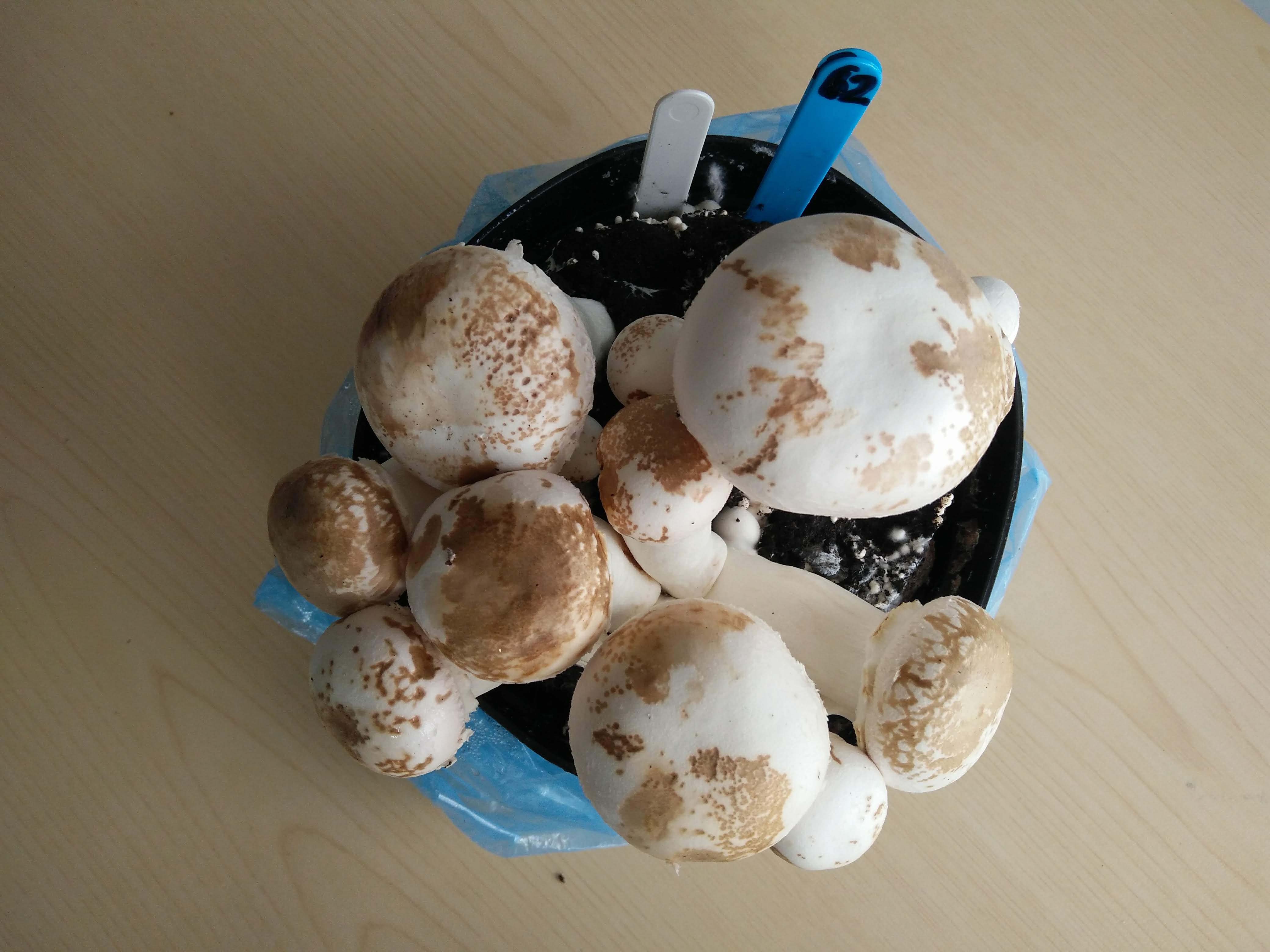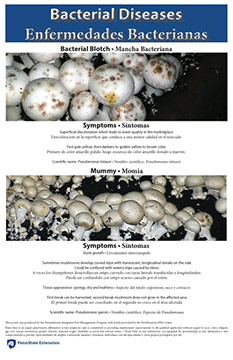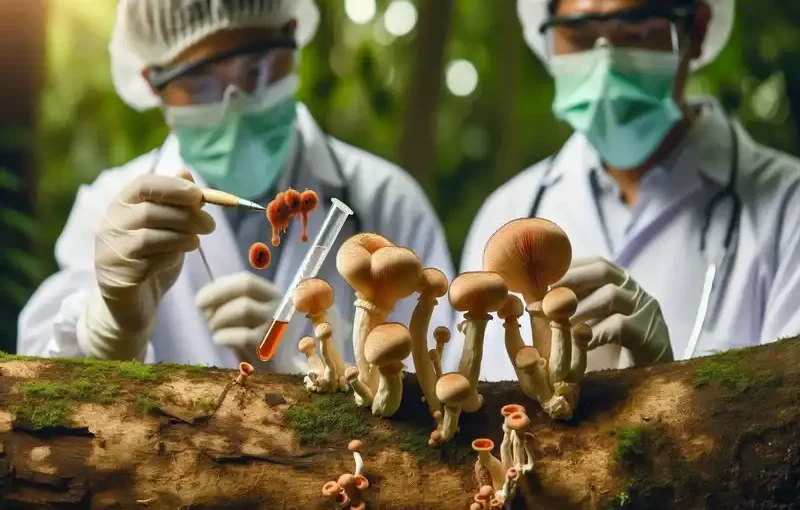Bacterial diseases in mushrooms can significantly reduce yield and quality. Common bacterial infections include Pseudomonas tolaasii and Pseudomonas agarici.
Mushrooms, like any other crops, are susceptible to various diseases, including bacterial infections. These diseases can severely impact mushroom cultivation, resulting in financial losses for growers. Pseudomonas tolaasii, responsible for brown blotch disease, and Pseudomonas agarici, causing drippy gill, are the most prevalent bacterial pathogens.
Early detection and proper management are crucial to minimizing damage. Effective strategies include maintaining optimal growing conditions, implementing strict hygiene practices, and using disease-resistant mushroom strains. Understanding the symptoms and preventive measures can help farmers protect their crops and ensure a healthy, productive mushroom harvest.

Credit: archive.ahdb.org.uk
Common Bacterial Diseases
Mushrooms are susceptible to various bacterial diseases. These diseases can harm mushroom growth and yield. Understanding common bacterial diseases helps in effective management.
Soft Rot
Soft Rot is a common bacterial disease in mushrooms. This disease causes the mushroom tissue to soften and decay. The infection starts with water-soaked spots on the mushroom.
These spots enlarge and turn brown or dark. Mushrooms become mushy and emit a foul odor. Soft Rot is caused by various bacteria, mainly Erwinia species.
Conditions that favor Soft Rot include:
-
- High humidity
- Poor ventilation
- Contaminated water
Brown Blotch
Brown Blotch is another bacterial disease affecting mushrooms. It is caused by the bacterium Pseudomonas tolaasii. Brown Blotch symptoms appear as yellow or brown spots on the mushroom cap.
These spots are irregular and may merge to form large blotches. The mushroom surface becomes slimy in humid conditions. This disease affects mushroom quality and marketability.
Factors promoting Brown Blotch include:
-
- High humidity
- Excessive watering
- Contaminated tools
Here is a table summarizing the key aspects of these diseases:
| Disease | Causing Bacteria | Symptoms | Promoting Factors |
|---|---|---|---|
| Soft Rot | Erwinia species | Water-soaked spots, soft tissue, foul odor | High humidity, poor ventilation, contaminated water |
| Brown Blotch | Pseudomonas tolaasii | Yellow or brown spots, slimy surface | High humidity, excessive watering, contaminated tools |

Credit: apsjournals.apsnet.org
Symptoms Of Infection
Mushrooms are susceptible to various bacterial diseases. Identifying symptoms early can prevent spread.
Here’s a detailed look at key symptoms of bacterial infections in mushrooms.
Discoloration
One of the first signs of infection is discoloration. Healthy mushrooms are typically white or light-colored. Infected mushrooms may show yellow, brown, or black spots.
These spots can be irregular in shape. The discoloration often starts small and spreads quickly. Early detection is crucial for control.
Odor And Texture Changes
Infected mushrooms can develop a foul odor. This smell is often sour or rotten. Healthy mushrooms have a mild, earthy scent. Along with odor, texture changes occur. The mushrooms may feel slimy or sticky. They might also become soft or mushy to touch. These changes indicate a severe infection.
Causes Of Bacterial Diseases
Bacterial diseases in mushrooms can devastate mushroom farms. Understanding the causes helps in preventing outbreaks. This section delves into the main causes of bacterial diseases in mushrooms.
Environmental Factors
Environmental factors play a significant role in the spread of bacterial diseases. Mushrooms thrive in humid and warm conditions. These conditions also favor bacteria growth. Poor ventilation can increase humidity levels. This creates a perfect environment for bacteria. Overwatering mushrooms can lead to waterlogged substrates. This is another ideal condition for bacteria.
Temperature fluctuations can stress mushrooms. Stressed mushrooms are more vulnerable to bacterial infections. Keeping a consistent environment is crucial.
Here are some critical environmental factors:
-
- High humidity
- Poor ventilation
- Overwatering
- Temperature fluctuations
Contaminated Tools
Using contaminated tools can introduce bacteria to mushroom farms. Tools used for harvesting, cutting, or planting must be clean. Dirty tools can spread bacteria from one mushroom to another.
Here are some tools that need regular cleaning:
-
- Harvesting knives
- Scissors
- Planting trays
Regular disinfection of tools helps in preventing bacterial spread. Use a mild bleach solution for cleaning tools. This ensures tools are bacteria-free.
Proper tool maintenance is vital for a healthy mushroom farm.
| Environmental Factor | Effect |
|---|---|
| High Humidity | Increases bacteria growth |
| Poor Ventilation | Traps moisture, promotes bacteria |
| Overwatering | Creates waterlogged substrates |
| Temperature Fluctuations | Stresses mushrooms, increases vulnerability |
Identification Techniques
Bacterial diseases can wreak havoc on mushroom crops. Identifying these diseases early is crucial for effective management. This section delves into the various identification techniques to detect bacterial diseases in mushrooms.
Visual Inspection
Visual inspection is the first step in identifying bacterial diseases. Look for specific symptoms on the mushroom caps and stems.
-
- Discoloration: Yellow, brown, or black spots.
- Soft Rot: Mushrooms become soft and mushy.
- Odor: Unpleasant smell indicating decay.
Regularly inspect your mushroom crops for these signs. Early detection can save your harvest.
Laboratory Testing
Laboratory testing provides a more accurate diagnosis. Use this method if visual inspection is inconclusive.
Common lab tests for bacterial diseases include:
-
- Microscopy: Examine samples under a microscope to identify bacteria.
- Cultural Techniques: Grow bacteria on nutrient media to study them.
- Molecular Methods: Use PCR to detect bacterial DNA.
| Test Type | Accuracy | Time |
|---|---|---|
| Microscopy | Moderate | 1-2 days |
| Cultural Techniques | High | 3-5 days |
| Molecular Methods | Very High | 1 day |
Choose the appropriate test based on your needs and resources. Lab tests can confirm the presence of specific bacteria.
Prevention Strategies
Mushroom cultivation is vulnerable to various bacterial diseases. These diseases can significantly reduce yield and quality. Implementing effective prevention strategies is crucial to maintain a healthy crop. The following sections outline some key strategies to prevent bacterial diseases in mushrooms.
Hygiene Practices
Maintaining good hygiene is essential for preventing bacterial diseases. Start by cleaning all tools and equipment regularly. Use a disinfectant to clean surfaces. Workers should wash their hands before handling mushrooms. Wear clean gloves and clothing during the cultivation process.
Regularly remove any plant debris or waste. Dispose of it away from the growing area. This helps prevent bacteria from spreading. Avoid using contaminated water for irrigation. Always use clean, fresh water.
Proper Ventilation
Proper ventilation is vital for mushroom health. It helps reduce humidity levels and prevents bacterial growth. Ensure your growing area has adequate air circulation. Use fans to increase airflow if necessary.
Monitor humidity levels closely. Keep them within the recommended range for mushroom cultivation. High humidity can lead to bacterial infections. Lowering humidity can help keep bacteria at bay.
Install vents or exhaust systems in the growing area. This helps remove excess moisture and stale air. Proper ventilation also ensures a consistent supply of fresh air, which is beneficial for mushrooms.
Treatment Options
Bacterial diseases in mushrooms can severely impact their growth and quality. Proper treatment options are crucial to ensure healthy mushroom cultivation. This section delves into both chemical and natural remedies for treating bacterial diseases in mushrooms.
Chemical Treatments
Chemical treatments involve using specific antibacterial agents to combat infections. These chemicals are usually applied in controlled amounts to prevent any adverse effects.
-
- Formalin: A common chemical used to disinfect mushroom growing areas.
- Chlorine: Chlorine solutions can help reduce bacterial load.
- Hydrogen Peroxide: Useful for sterilizing equipment and surfaces.
- Bleach: Diluted bleach solutions can disinfect contaminated areas.
Always follow the manufacturer’s instructions when using chemical treatments. Wear protective gear to avoid exposure.
Natural Remedies
Natural remedies are safer and environmentally friendly. They can be just as effective in treating bacterial diseases in mushrooms.
-
- Garlic Extract: Garlic has natural antibacterial properties. Use a diluted garlic solution to spray affected areas.
- Tea Tree Oil: Mix tea tree oil with water and apply it to contaminated spots.
- Vinegar: A vinegar solution can help disinfect and reduce bacterial growth.
- Aloe Vera Gel: Aloe vera contains compounds that fight bacteria. Apply it directly to infected mushrooms.
Using natural remedies minimizes chemical exposure and is better for the environment. Always test a small area first to ensure it does not harm the mushrooms.
Combining both chemical and natural treatments can offer a balanced approach. This ensures the best results in combating bacterial diseases in mushrooms.
Impact On Mushroom Yield
Bacterial diseases can severely harm mushroom crops. This leads to reduced yields. Healthy yields are crucial for mushroom farmers. Let’s explore how these diseases affect production.
Economic Losses
Bacterial infections cause significant economic losses for mushroom growers. Contaminated mushrooms can’t be sold. This results in lost revenue. Farmers must also spend money to control these diseases. Costs include buying disinfectants and other treatments.
| Cause | Economic Impact |
|---|---|
| Contaminated Crops | Revenue Loss |
| Treatment Costs | Increased Expenses |
| Reduced Yield | Lower Profits |
Quality Reduction
Bacterial diseases also lead to quality reduction in mushrooms. Infected mushrooms may have spots or discolorations. These are less appealing to buyers.
Quality issues can be categorized as:
-
- Visual defects
- Texture changes
- Taste alterations
Visual defects make mushrooms look unappealing. Texture changes can make them less enjoyable to eat. Taste alterations can affect the overall flavor. All these factors lower the quality of the final product.
Best Practices For Mushroom Growers
Mushroom growers face challenges from bacterial diseases that can devastate crops. Following best practices can prevent these problems and ensure healthy harvests. Below are essential strategies for managing bacterial diseases in mushrooms.
Regular Monitoring
Regular monitoring is crucial for detecting bacterial diseases early. Inspect your mushroom crops daily. Look for signs of bacterial infections, such as discoloration and sliminess.
Create a monitoring schedule and stick to it. Record any unusual observations in a logbook. This helps in tracking patterns and identifying recurrent issues.
Use clean tools for monitoring to avoid spreading bacteria. Disinfect tools after each use.
| Monitoring Task | Frequency | Notes |
|---|---|---|
| Visual Inspection | Daily | Check for discoloration and sliminess |
| Logbook Entry | Daily | Record any unusual signs |
| Tool Disinfection | After each use | Use a proper disinfectant |
Training And Education
Training and education are vital for preventing bacterial diseases in mushrooms. Ensure all workers understand the importance of hygiene and proper handling techniques.
Conduct regular training sessions for your team. Cover topics such as identification of bacterial diseases and proper sanitation practices. This keeps everyone informed and vigilant.
Provide educational materials like pamphlets and posters. Place them in common areas where workers can easily access them.
-
- Organize monthly training sessions.
- Distribute educational materials.
- Encourage questions and discussions.
Stay updated with the latest research and advancements in mushroom farming. Implement new strategies as needed to maintain crop health.
Regular monitoring and continuous education are key to successful mushroom growing. By following these best practices, growers can effectively manage bacterial diseases and ensure a healthy yield.

Credit: www.northeastipm.org
Frequently Asked Questions
What Is A Bacterial Contamination In Mushroom Substrate?
Bacterial contamination in mushroom substrate occurs when harmful bacteria outcompete mushroom mycelium. This inhibits mushroom growth and causes spoilage. Cleanliness and sterilization prevent contamination.
What Causes Bacterial Diseases In Mushrooms?
Bacterial diseases in mushrooms are primarily caused by pathogenic bacteria like Pseudomonas, which thrive in moist conditions.
How To Identify Bacterial Blotch In Mushrooms?
Bacterial blotch appears as yellow to brown spots on the mushroom cap, often becoming slimy under high humidity.
Can Bacterial Diseases Spread Between Mushrooms?
Yes, bacterial diseases can spread through water, tools, and contaminated substrates, affecting multiple mushrooms in a crop.
How To Prevent Bacterial Diseases In Mushrooms?
Ensure proper ventilation, avoid excessive moisture, and sterilize tools and growing areas to prevent bacterial infections.
Conclusion
Understanding bacterial diseases in mushrooms is crucial for healthy cultivation. By following proper practices, growers can prevent infections.
Regular monitoring and quick action can save crops from major damage. Stay informed and proactive to ensure your mushroom farm thrives. Healthy mushrooms lead to better yields and a successful business.
